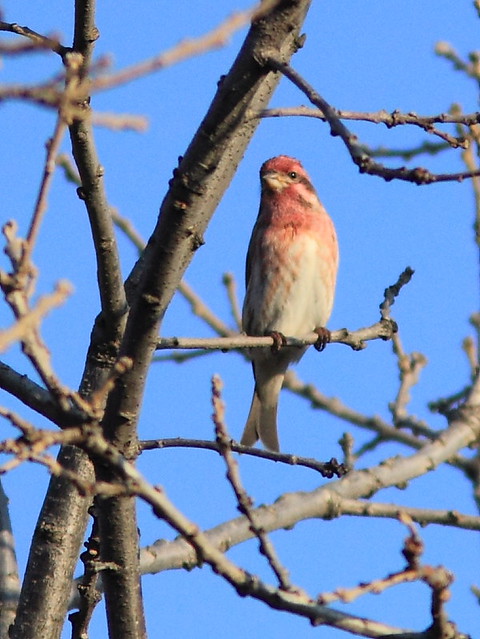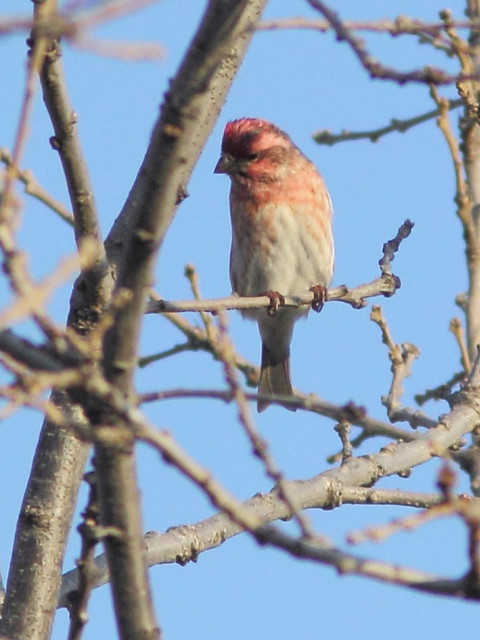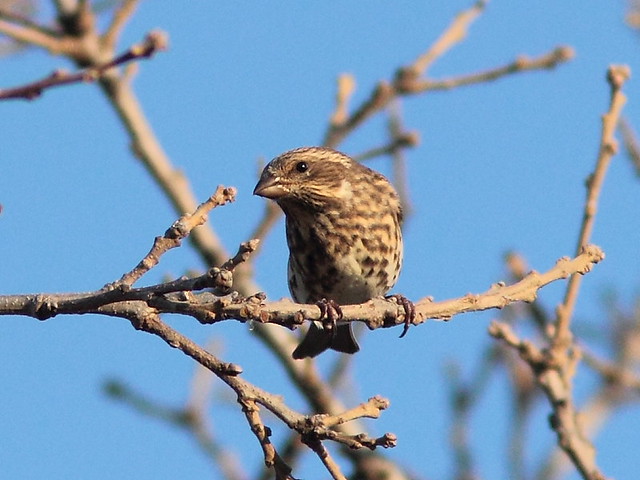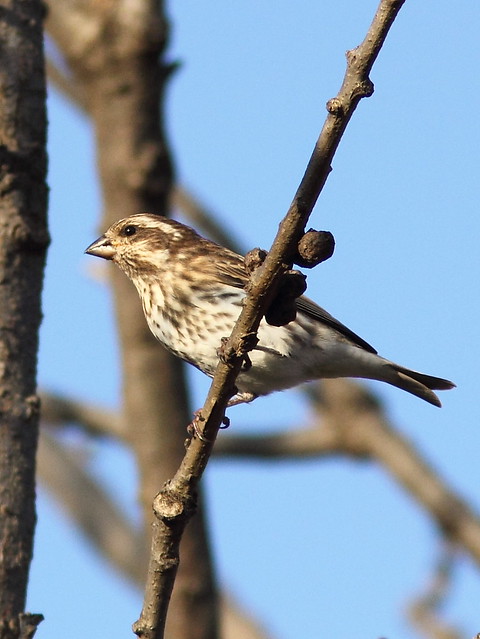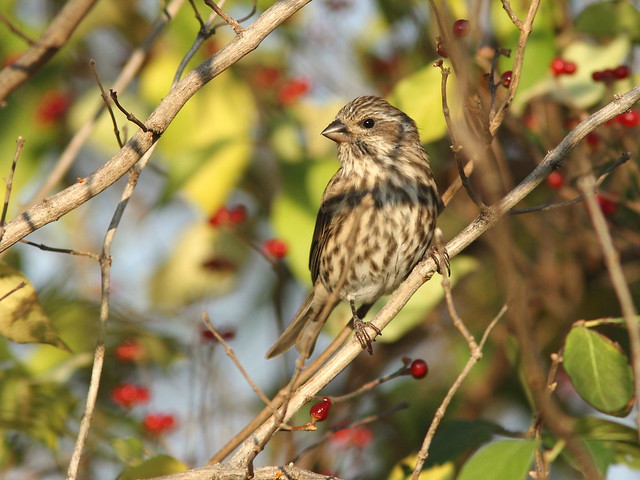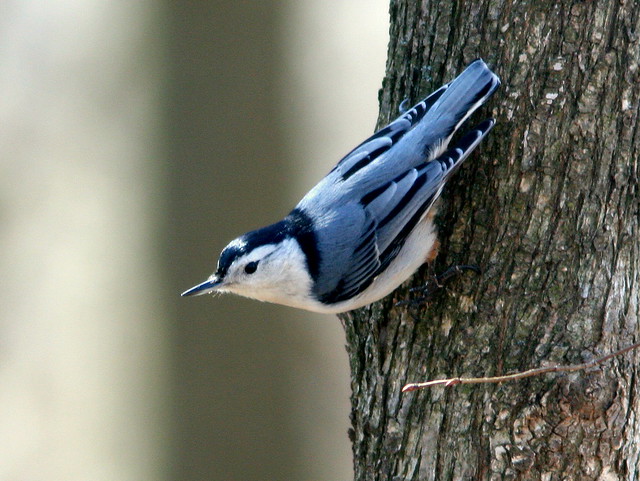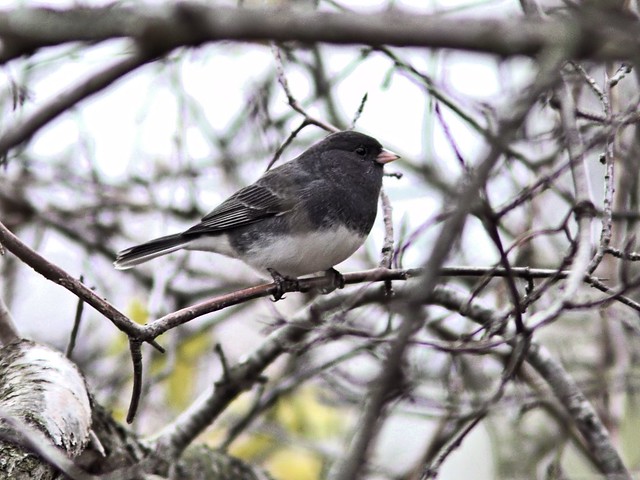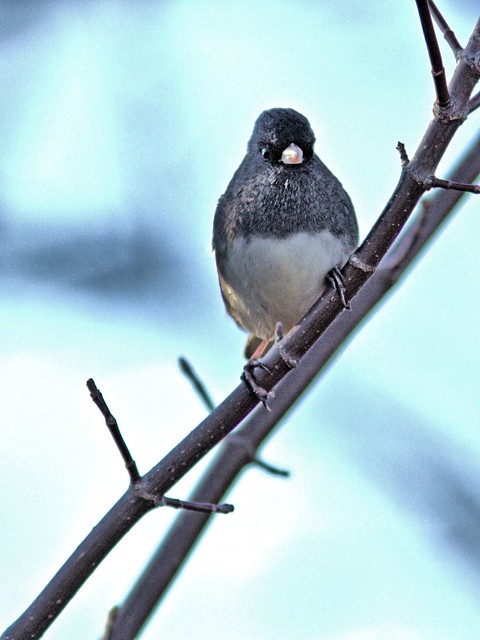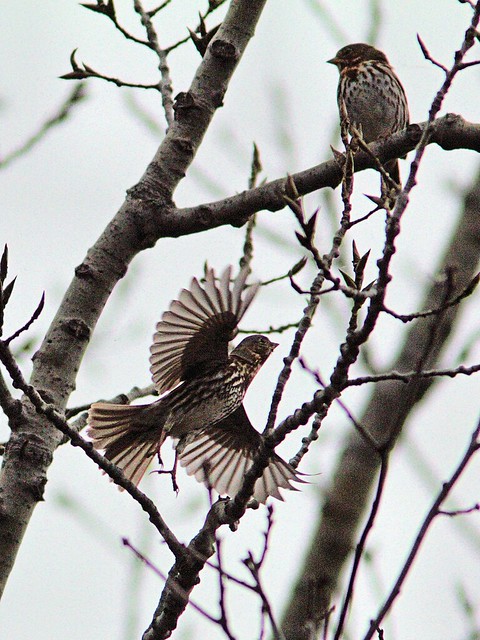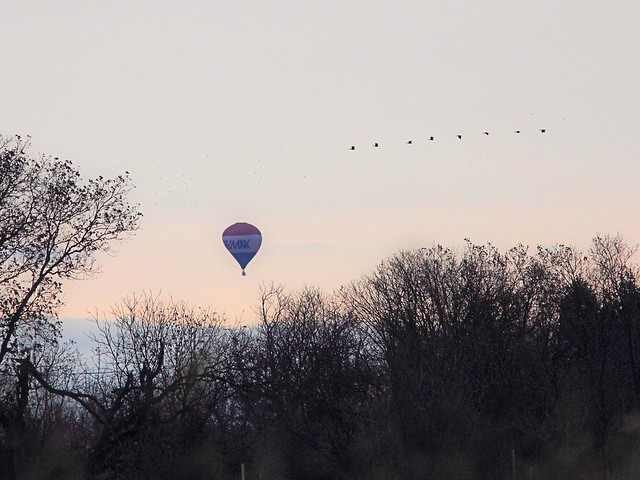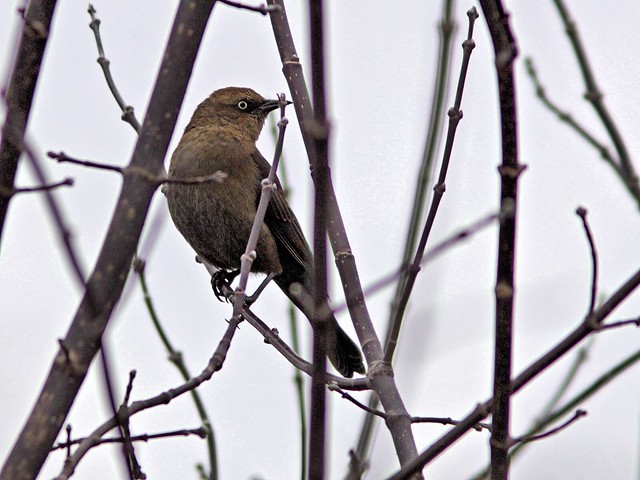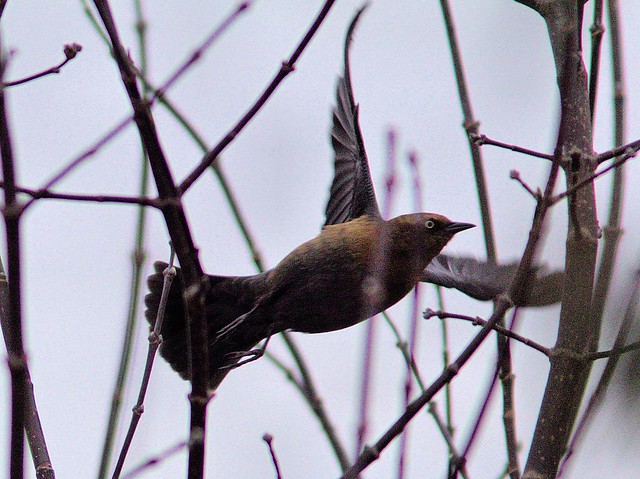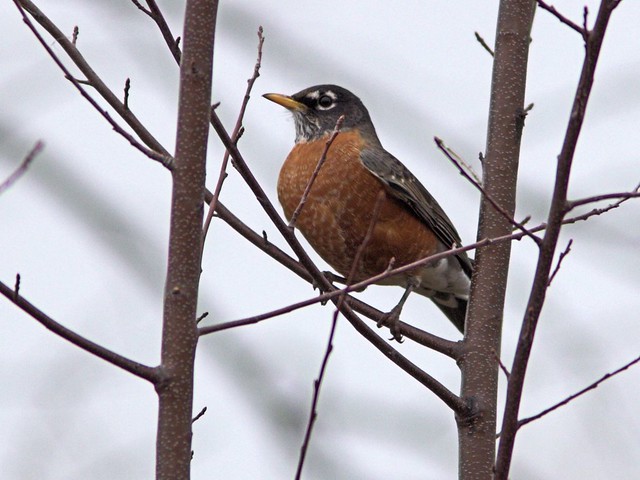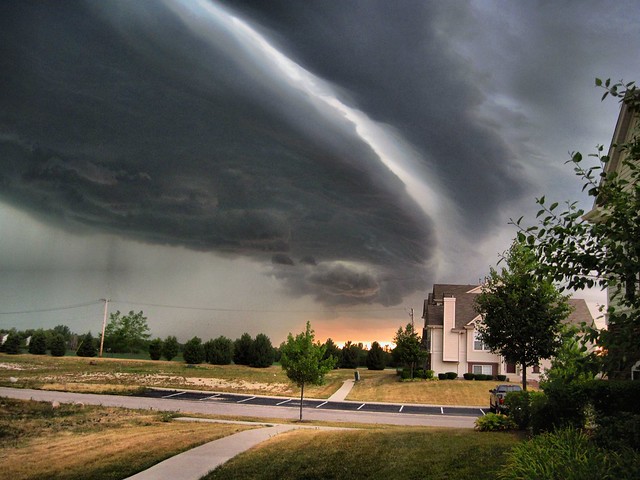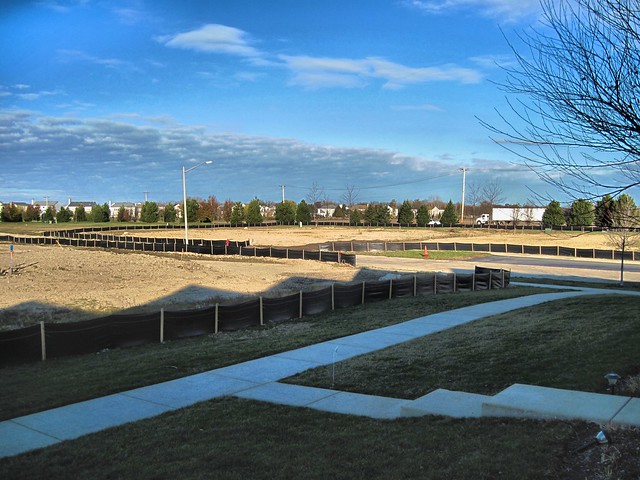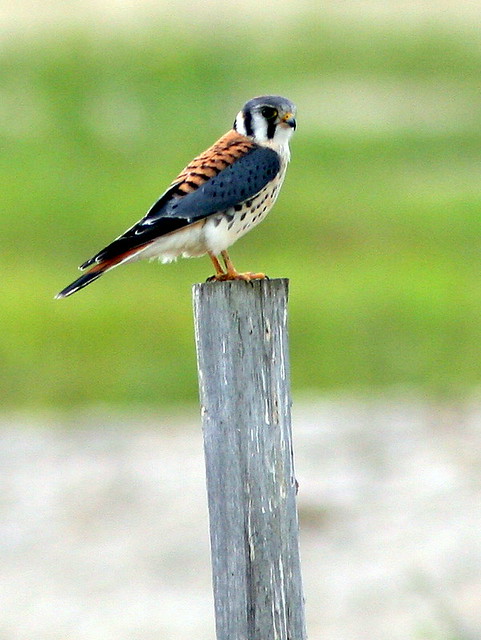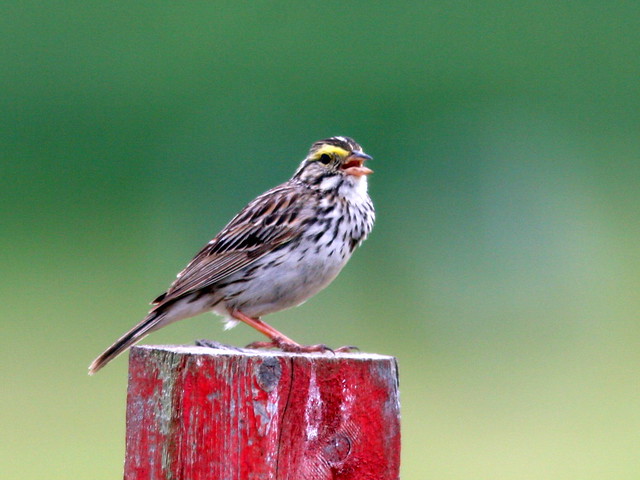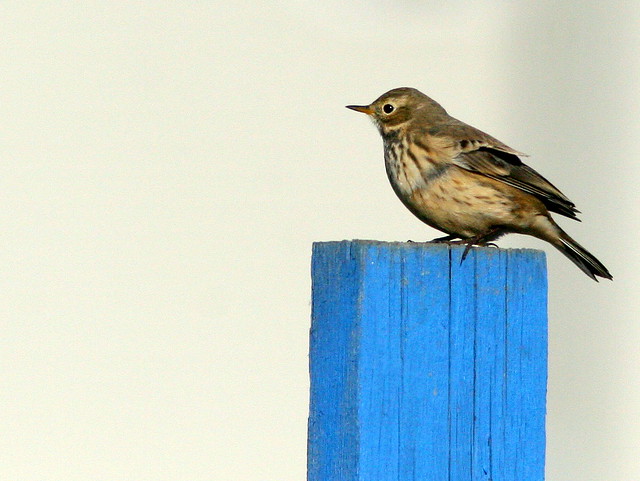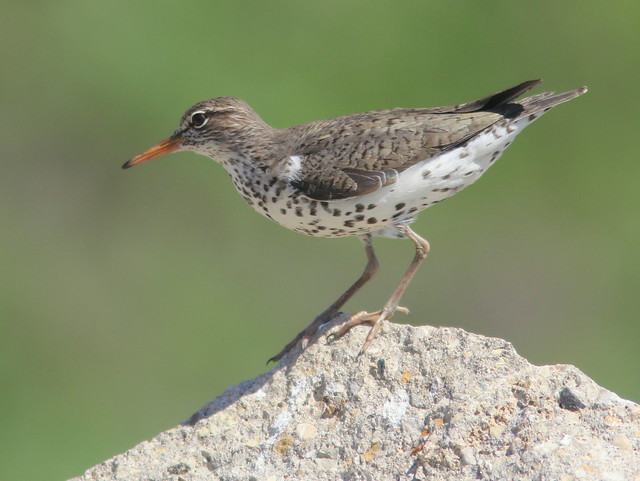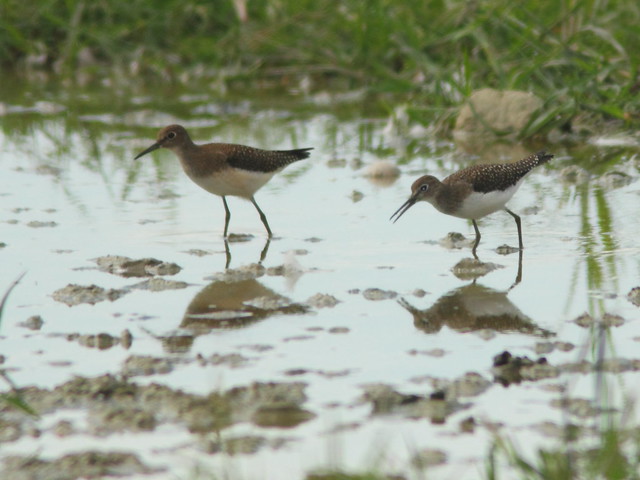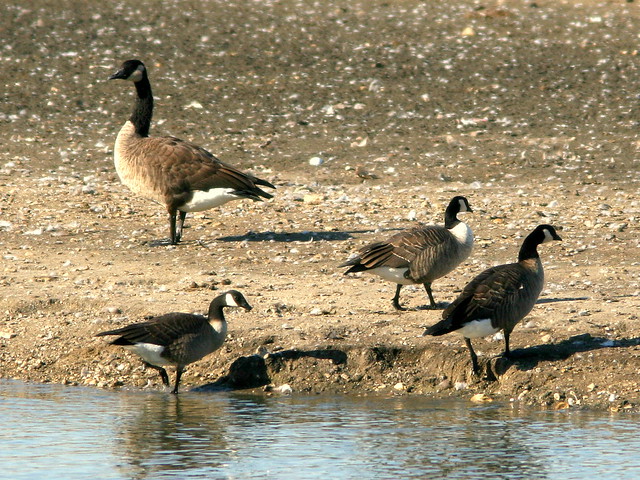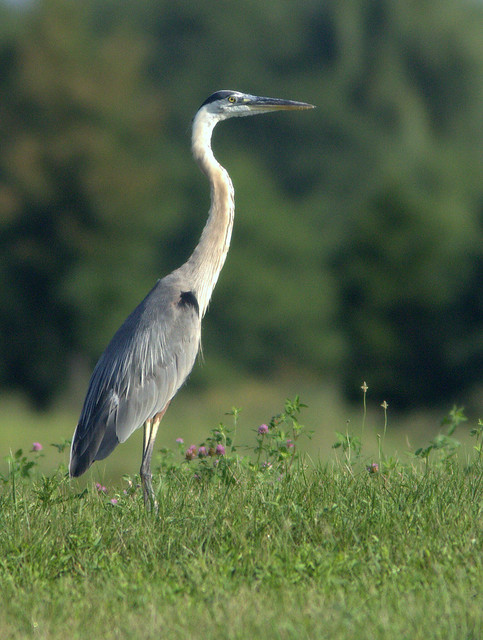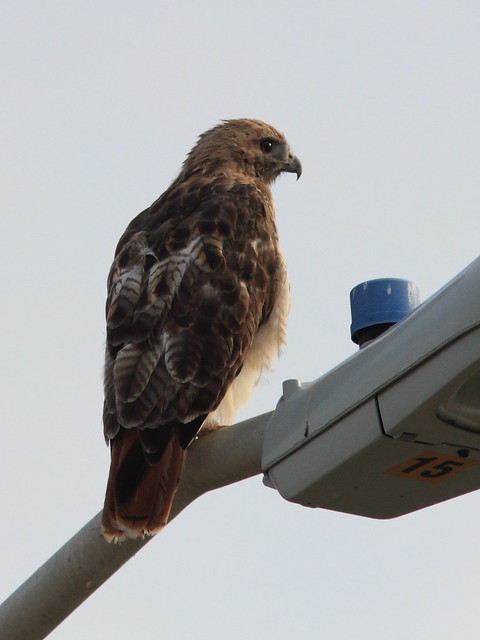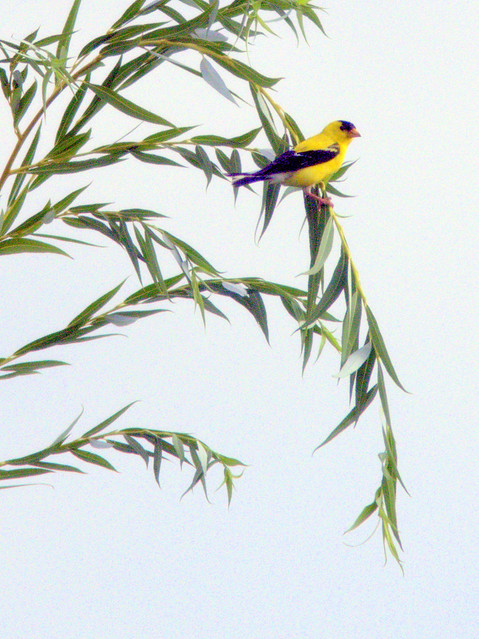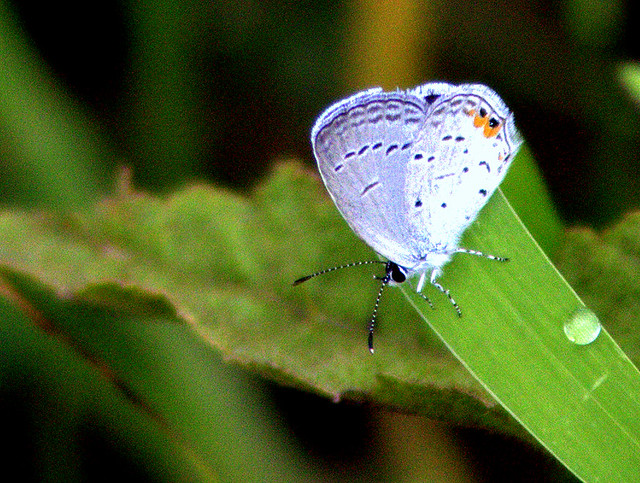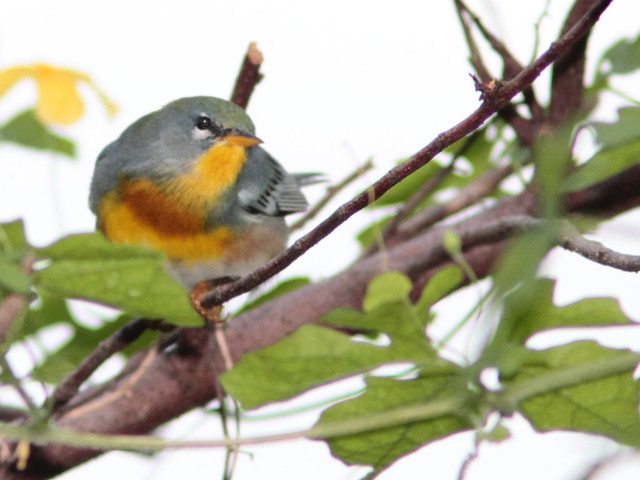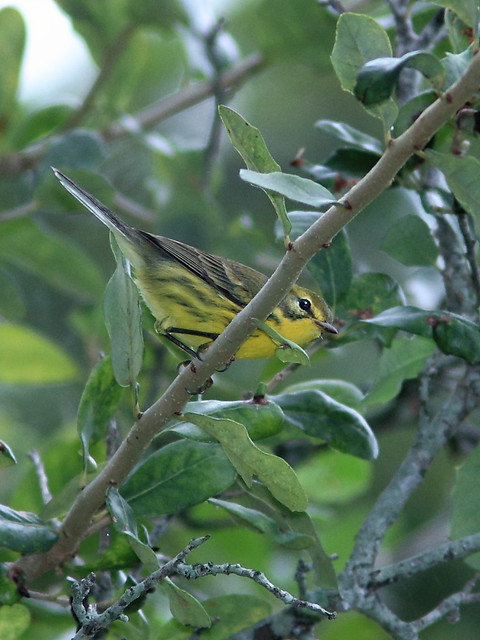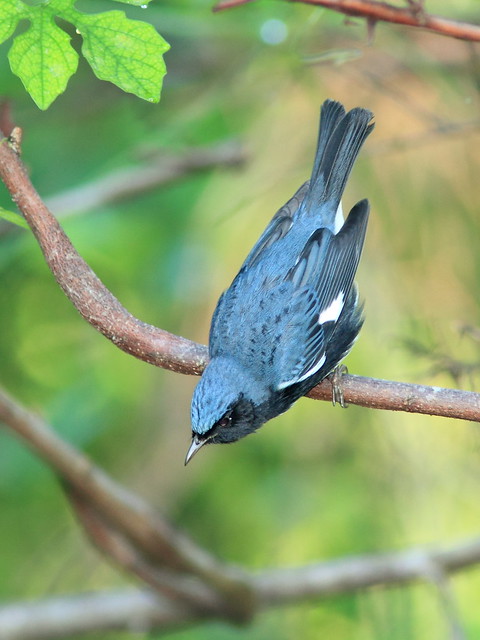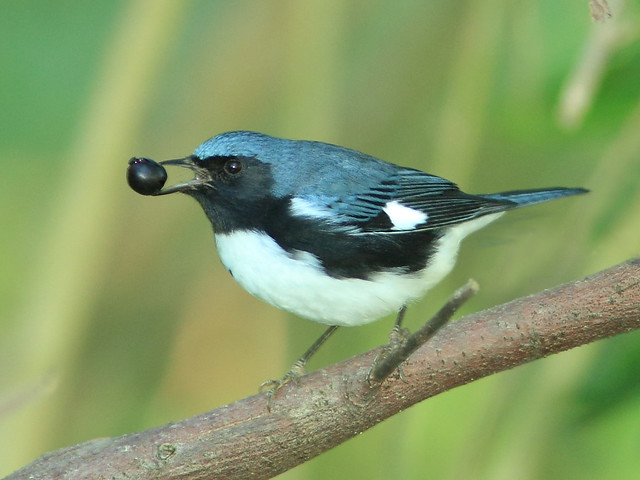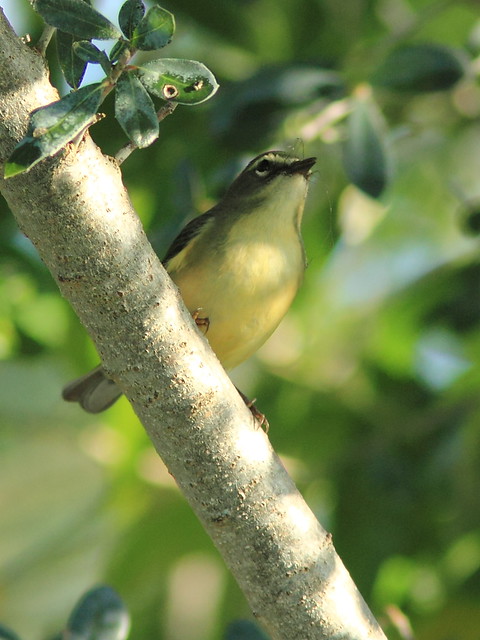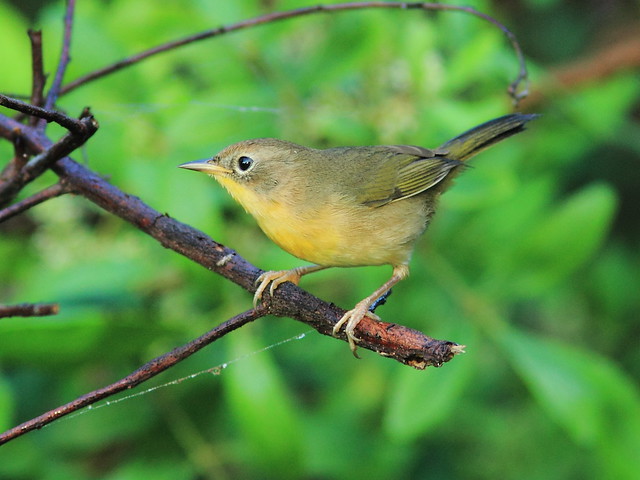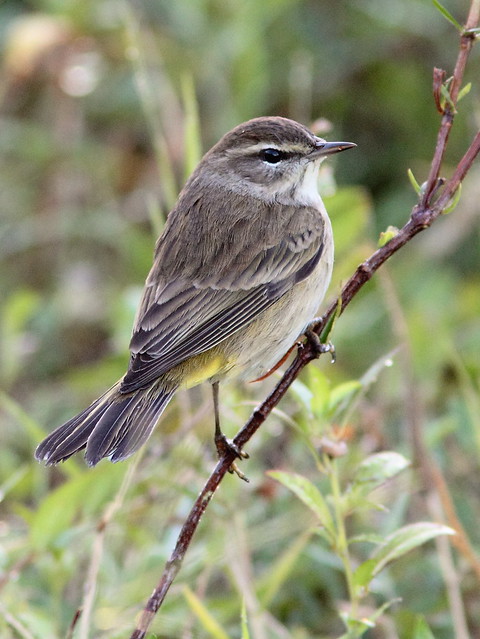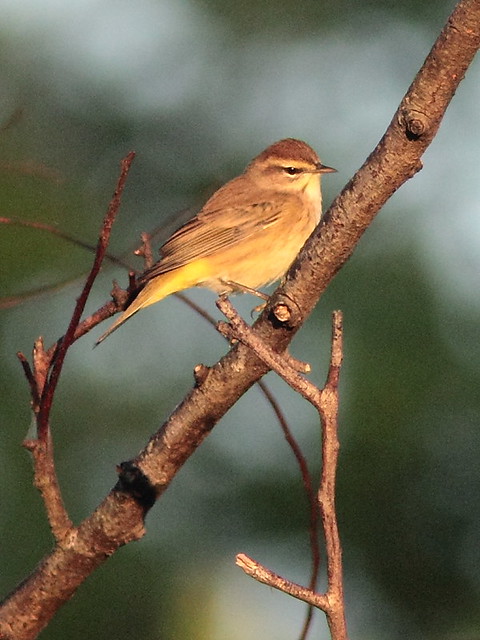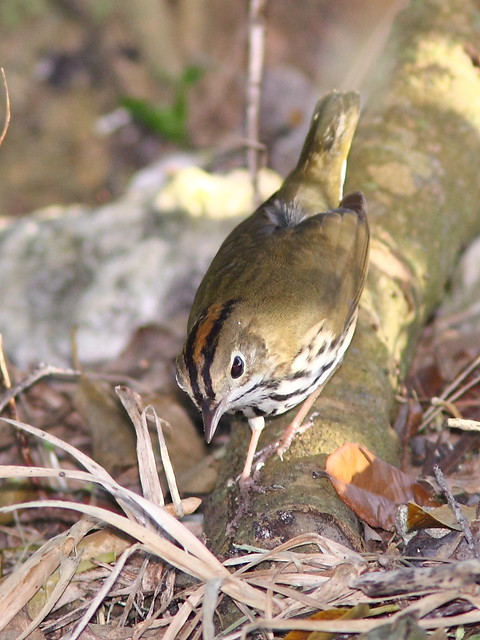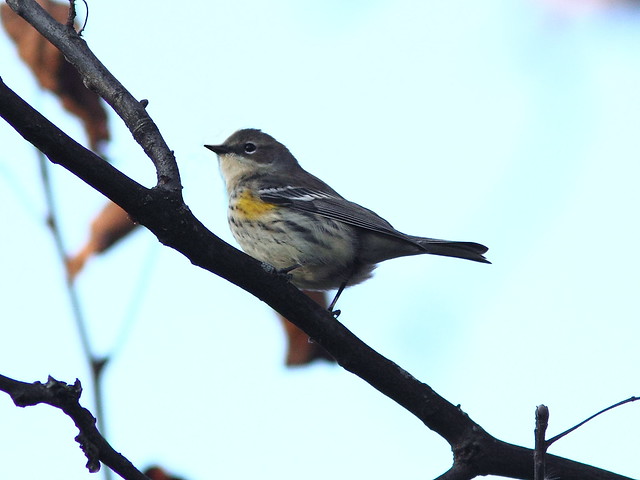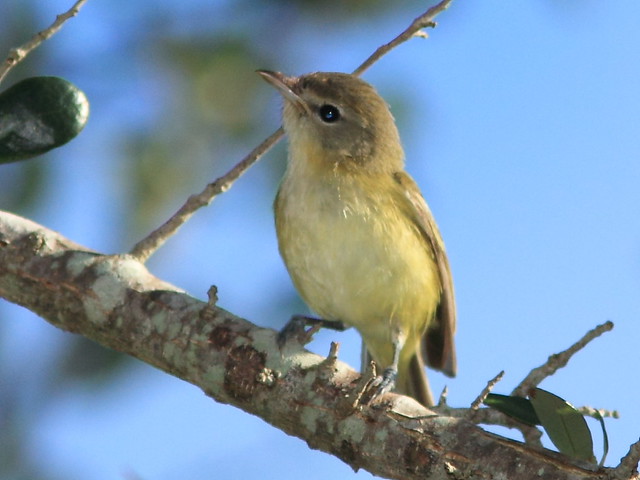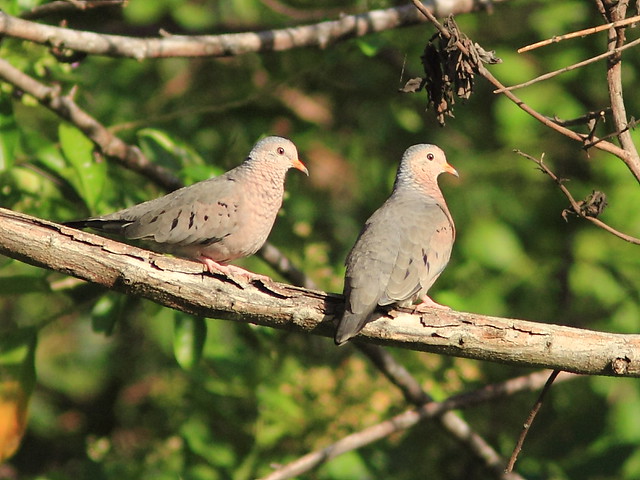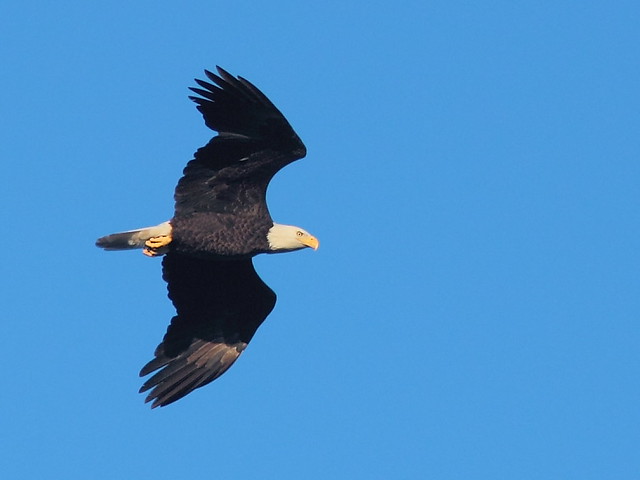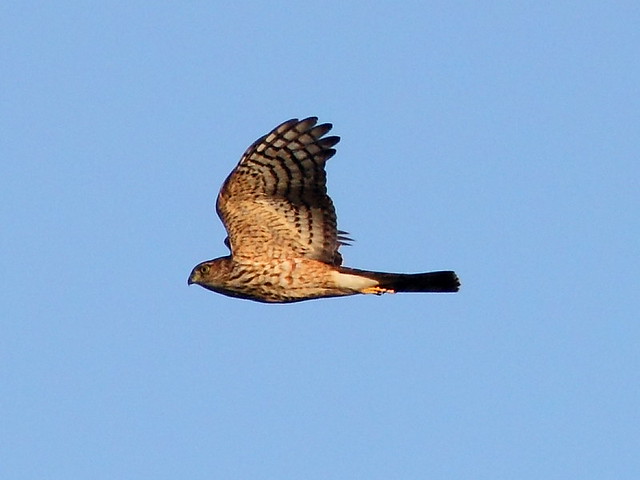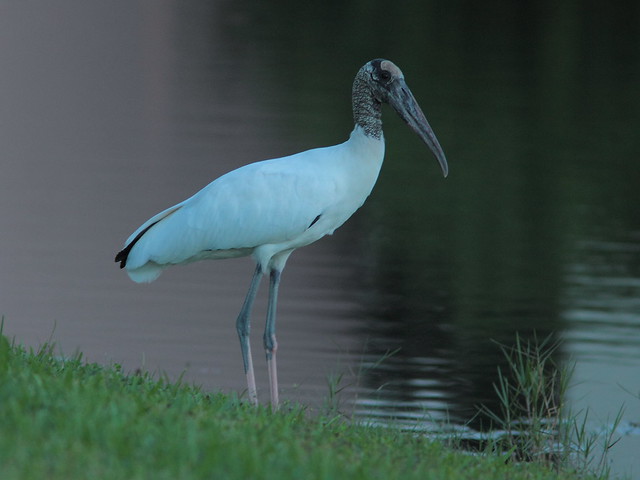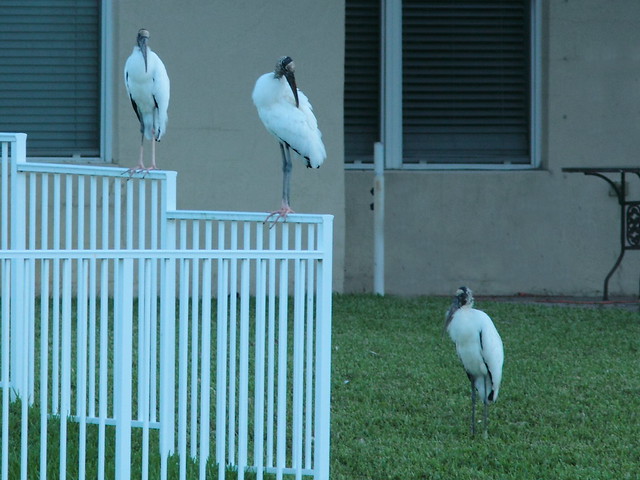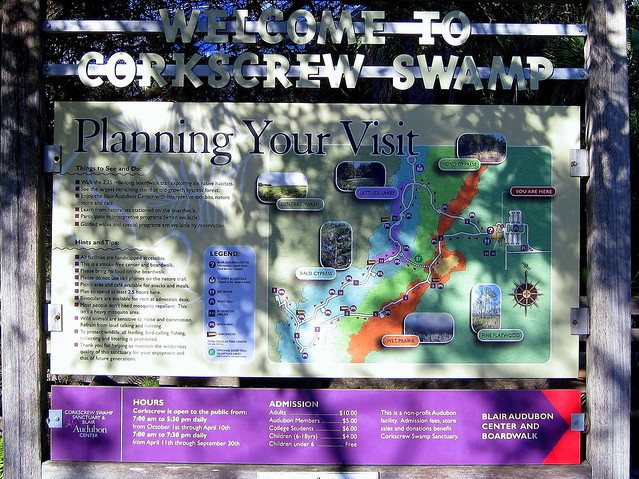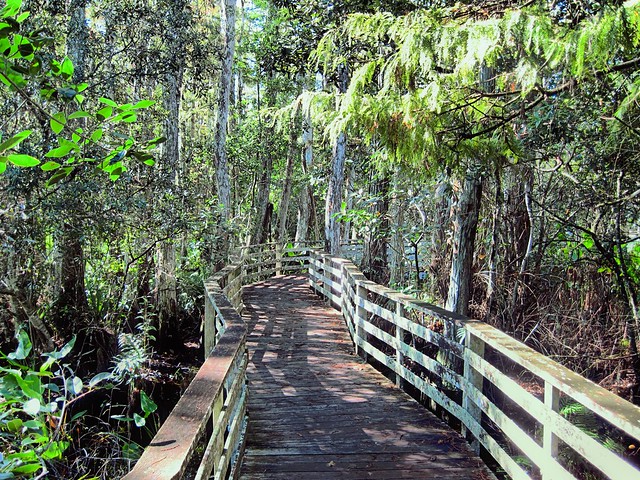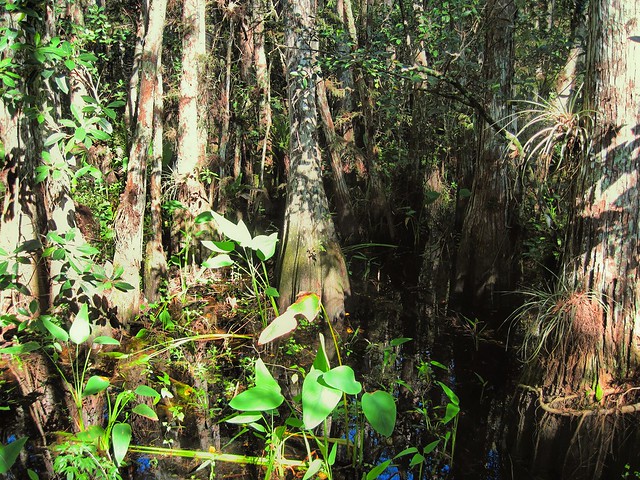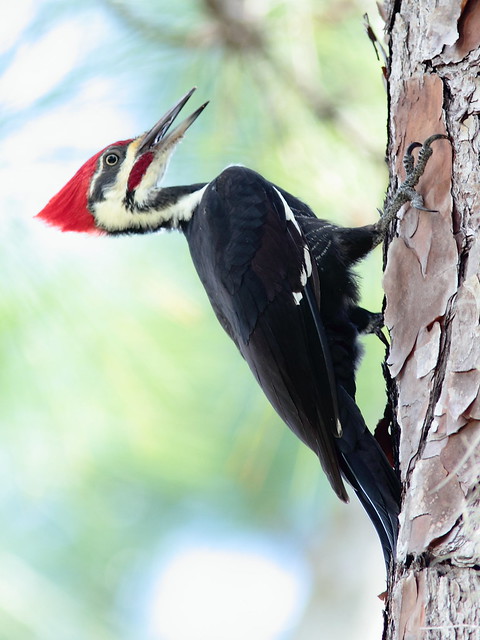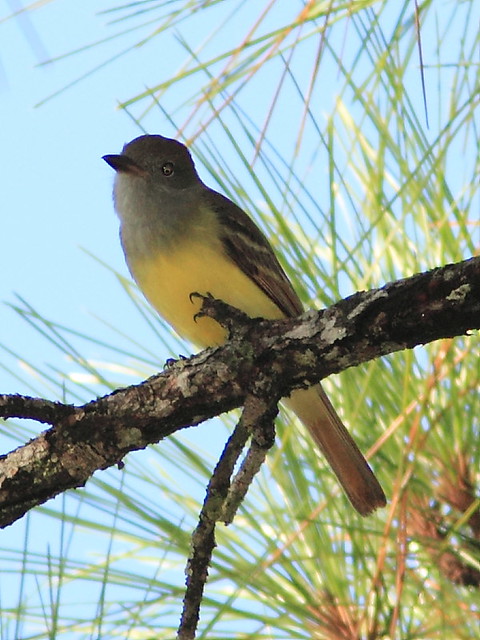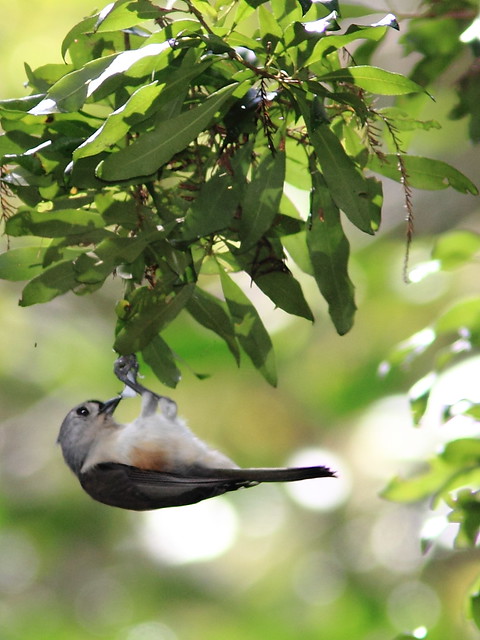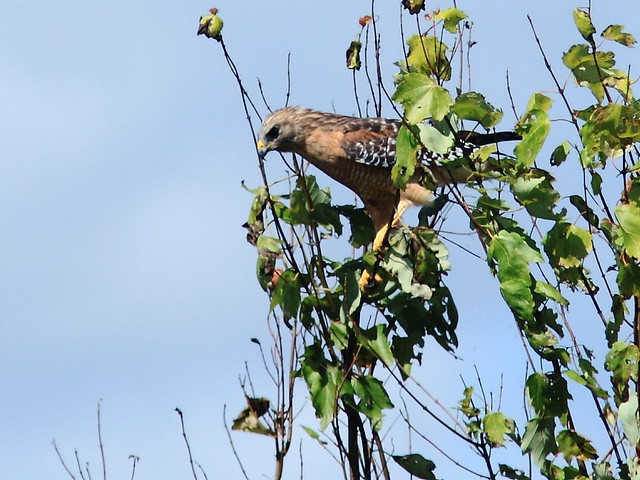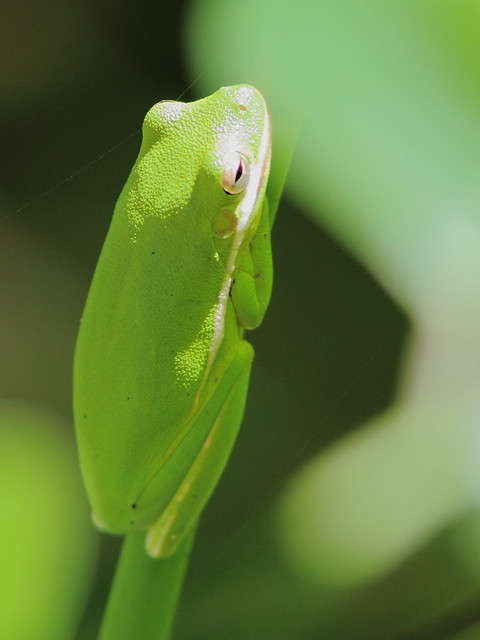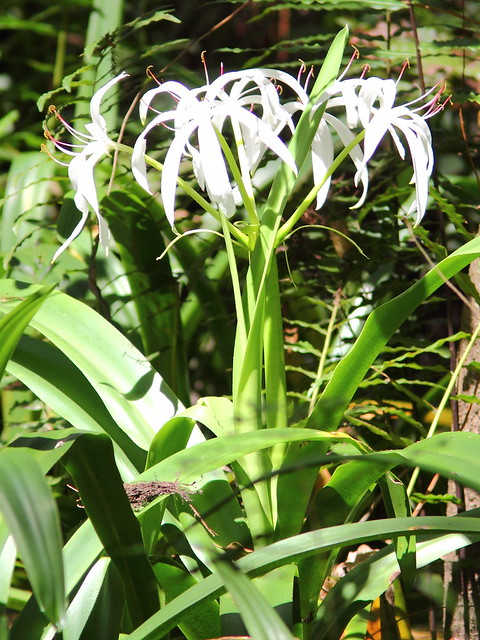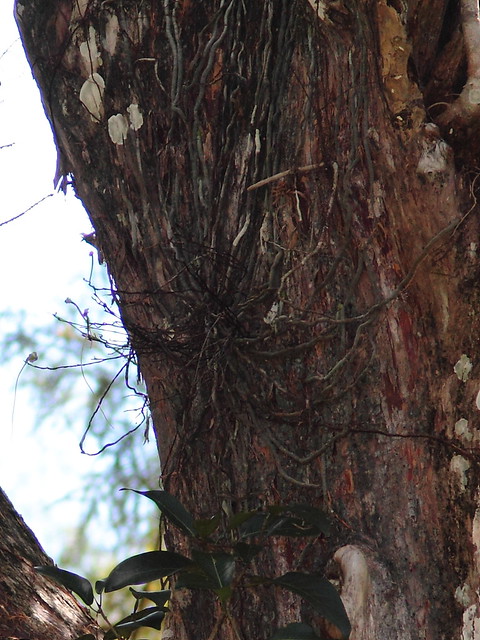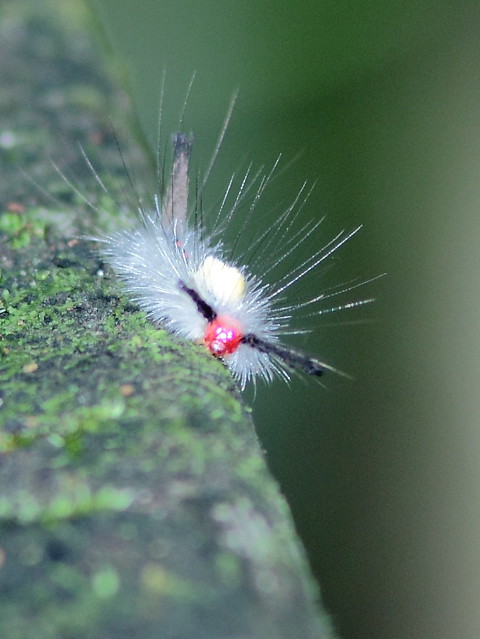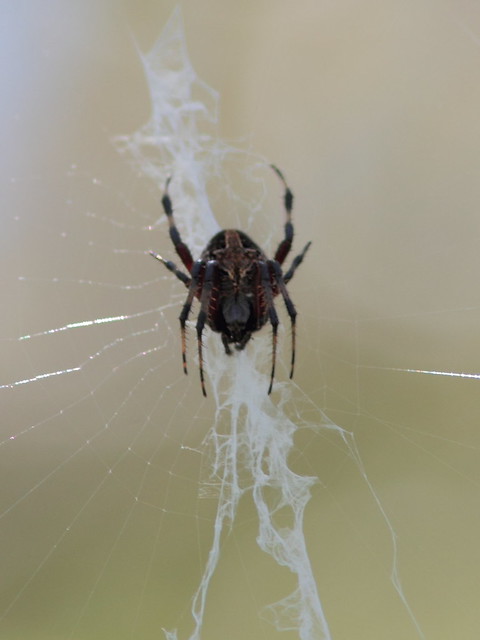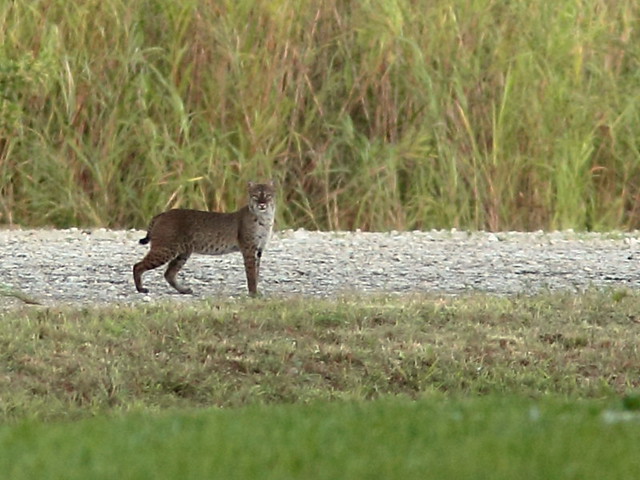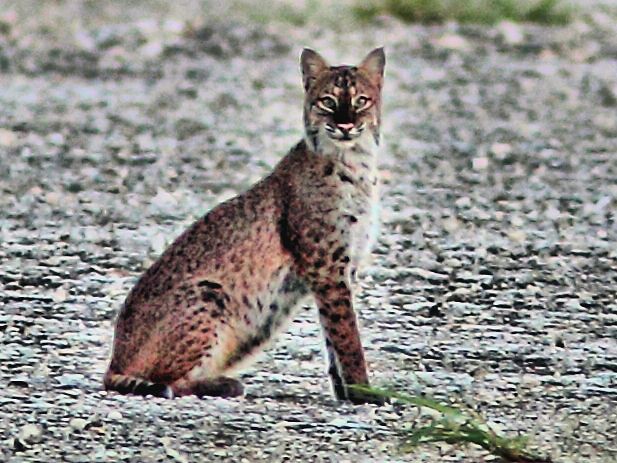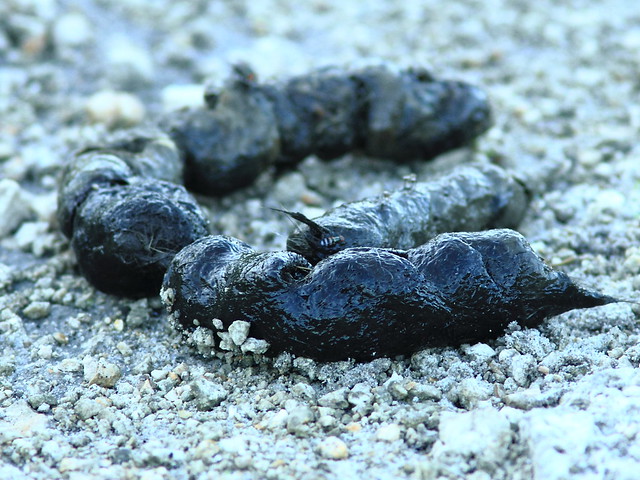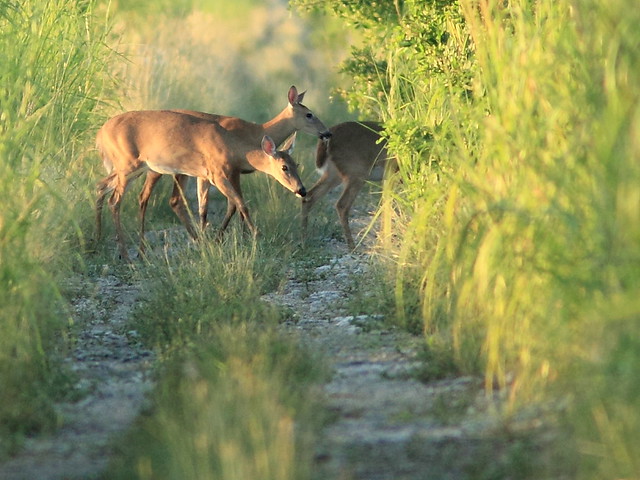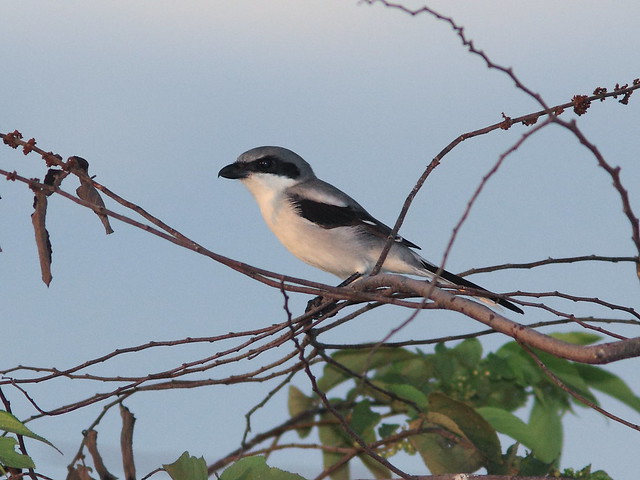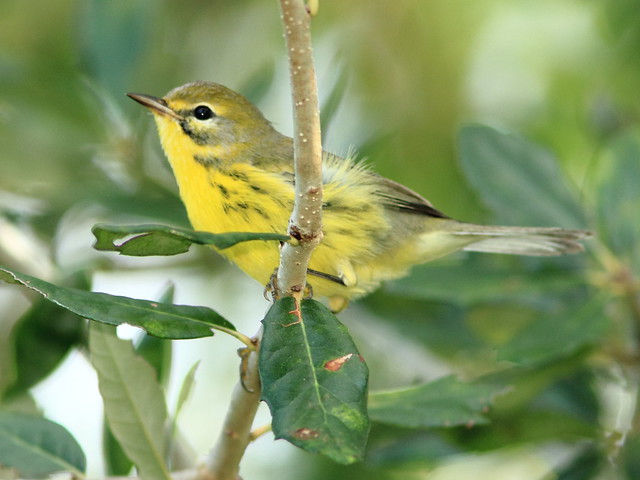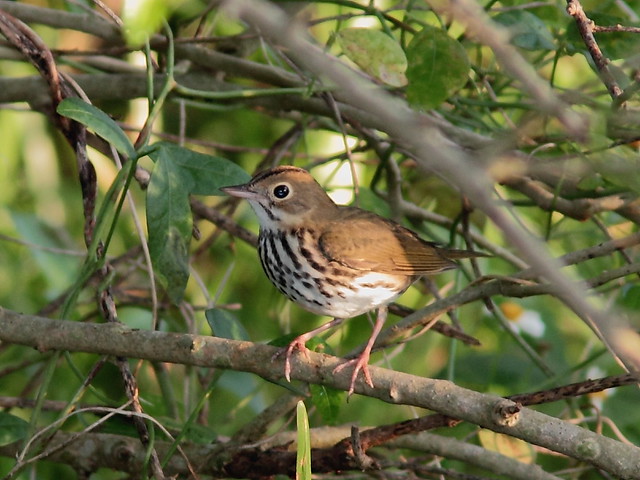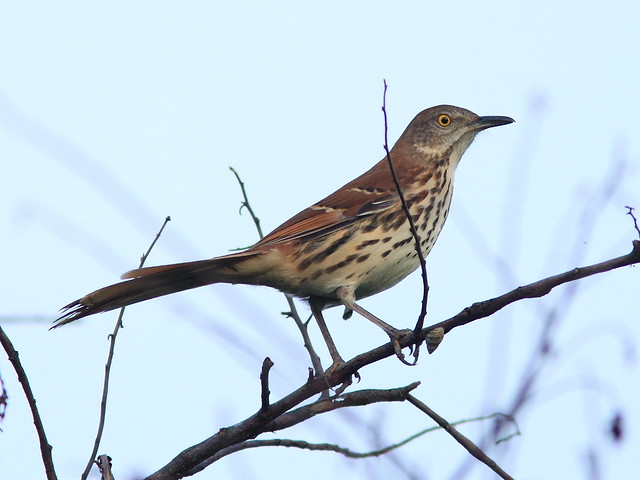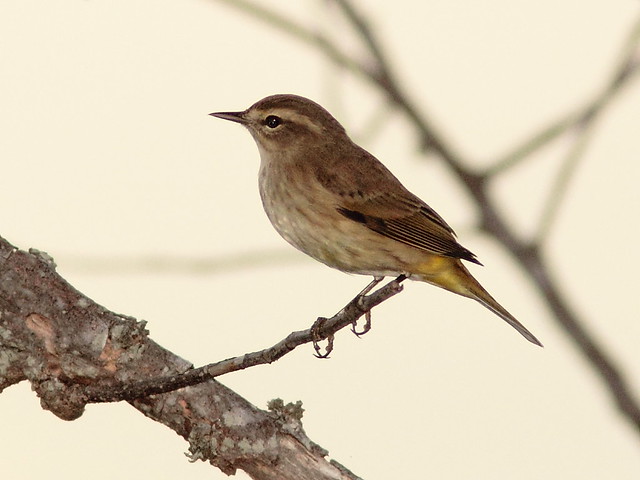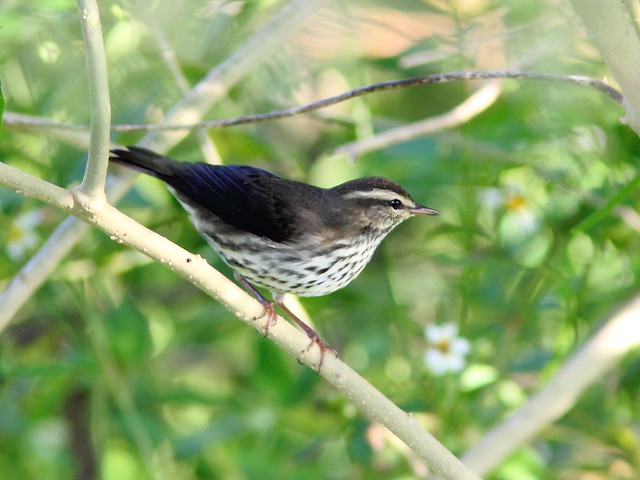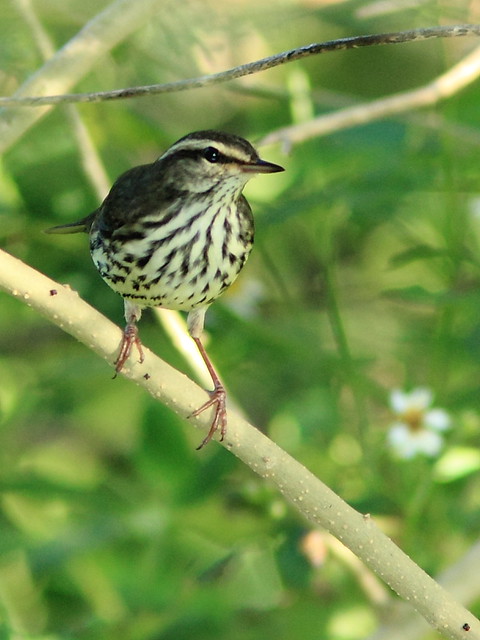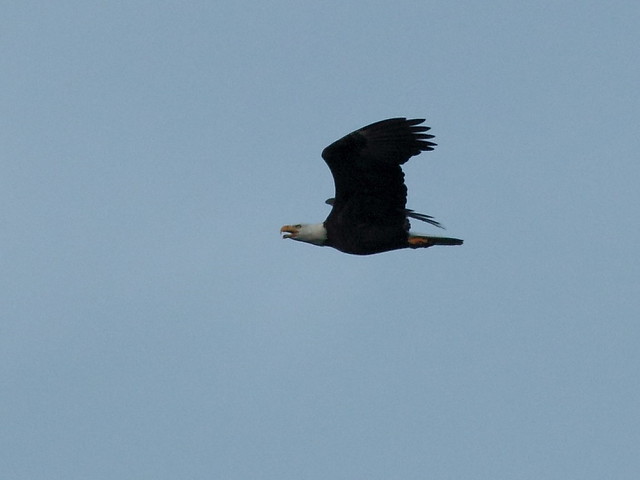Posted by: Ken @ 6:10 am
Hurricane Sandy brushed by a couple of days after our departure, but otherwise we picked a terrible time to leave south Florida! The low temperatures at our Florida home are finally dipping to around 60 degrees (F), about 20 degrees warmer than the daily highs in Chicagoland.
On our first morning upon returning to our Illinois condo, Mary Lou and I got out early to the east side of nearby Nelson Lake/Dick Young Kane County Forest Preserve. We immediately encountered a flock of 20+ Purple Finches that ranged in the woodlands at the lake’s eastern edge. Only one or two were in adult male plumage. It was this fall’s first reported sighting of the northern species at Nelson Lake.
They bear some resemblance to the common resident House Finches (photos below), a few of which joined the Purple Finches. Note that the upper edge of this House Finch’s bill (the culmen) curves down slightly, parrot-like. It also has shorter wings, less pronounced facial markings, darker streaks on its breast, and a shorter tail that is not notched as strongly as that of the more robust Purple Finch.
Here is another House Finch, showing how the red color of its forehead and breast has an orange tint (”brick colored”) while that of the Purple Finch looks richer rosy-pink or purple and suffuses its head and upper back and chest (as if dipped head first in raspberry juice).
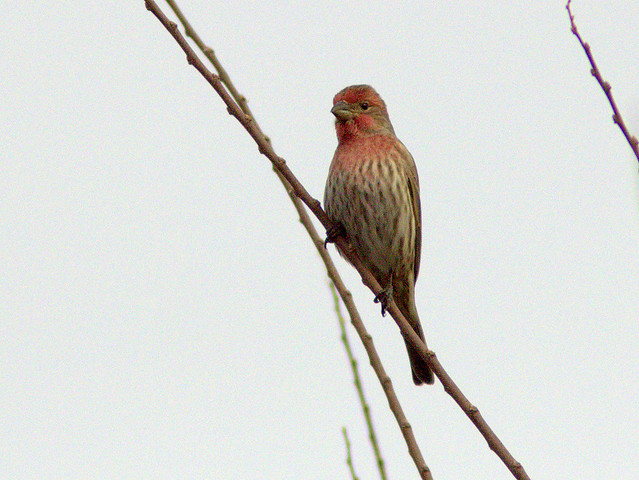
The other Purple Finches were brown females and hatch-year males. They are boldly streaked and exhibit a bright white line over their eyes and a straight culmen.
Several remained at close range as they feasted on berries.
For comparison, here is a photo of a female House Finch. Its face is noticeably plain and its streaks are less well-defined against a grayish background.
A Brown Creeper worked its way methodically up the trunk of a tree.
In typical fashion, the creeper flew to the bottom of an adjacent tree and again moved upward, while a White-breasted Nuthatch (”upside-down bird”) tended to do the opposite. Between the two species, both the upper and lower areas of the crevices in the bark are more thoroughly gleaned.
The first Saturday of each month is “Scope Day” a Nelson Lake. Despite freezing temperatures, about a dozen birders showed up. The lake shore usually extends much more closely to the viewing platform, but this year’s drought has taken a toll.
It was nice seeing (Slate-colored subspecies) Dark-eyed Juncos, hardy little winter visitors who do not make it down to south Florida. This one seemed to have indistinct wing bars, suggesting it might have some of the White-winged subspecies in its lineage.
Fox Sparrows were present in good numbers, many of them singing as if it were spring.
We saw a flock of seven unidentified swans, but they disappeared behind the trees before I could raise my camera. Canada Geese flew across the same area of sky. A hot air balloon added interest to the scene.
I also captured a pair of distant Sandhill Cranes in flight.
Hundreds of Common Grackles and other blackbirds, mostly Red-winged, flew overhead. Among them could be heard the calls of Rusty Blackbirds, a species I had seen before but never photographed. Luckily, a flock settled in a nearby tree, and I could pick out a few of the brownish Rusty species. They are slightly larger and have longer tails and more slender bills than Red-winged Blackbirds, but are smaller than grackles. Their pale eyes contrast with their dark faces.
A species of conservation concern, the Rusty Blackbird population is declining. There is no clear explanation as to why their numbers have significantly decreased 90% over the past 30 years, both in their breeding grounds in far northern boreal forests and in their winter range. Theories about the cause of the drop in population include destruction of winter and or breeding habitat and acid rain (read more here). Even though they associate with the Red-winged species, the Rusty Blackbirds often stay slightly away from their relatives, making them stand out.
It’s always nice to see American Robins, as they do not nest in south Florida and only show up there irregularly during the winter.
The past two weeks have been very eventful here in Illinois, limiting our time afield (as well as computer face time). Our son-in-law was deer hunting in North Carolina and fell as he was climbing into a tree stand. He broke bones in both legs and after he was stabilized was flown back to Illinois. Since he fell from a height of 20 feet, he is lucky that he landed on his feet rather than his head or back, as he could have been paralyzed or killed. He needed surgery (ten screws, two pins, a metal plate and cadaver bone transplants) on both legs and got out of the hospital only yesterday. We have been busy minding our two granddaughters.
We are looking forward to our return to Florida, where our local pair of Bald Eagles is preparing to start a family. Here is one of the pair that I photographed last breeding season.
Posted by: Ken @ 6:24 am
One’s priorities change over time. The inevitable and the unexpected, and the balance between wants and needs all come into play. Getting drafted in 1966 and suddenly moving from New Jersey to west Texas with our three children was jarring, yet eventful in a very positive way. We selected our El Paso rental home mostly because of its convenience to schools, work and shopping. The expansive blue sky and the mountainous backdrop were pleasant but not necessary. Likewise, our subsequent homes in New Orleans and Dallas were chosen with similar needs in mind.
Only after 27 years, when retirement approached and we were “empty nesters” did we think about what we really wanted in a home. My love for the southwest was an overwhelming consideration. For Mary Lou, proximity to family was an equally important factor. On one of my business trips to New Mexico I learned of a new subdivision under construction. In a moment of free time I visited the site and called the number on the real estate agent’s sign. After a short visit I selected a home site and called Mary Lou to seek her agreement on entering into a contract. Despite her reluctance about the fact that I had not yet even set a retirement date, I knew she shared my feelings about the region. Besides, two of our children lived within a few hours drive, in Texas and Arizona.
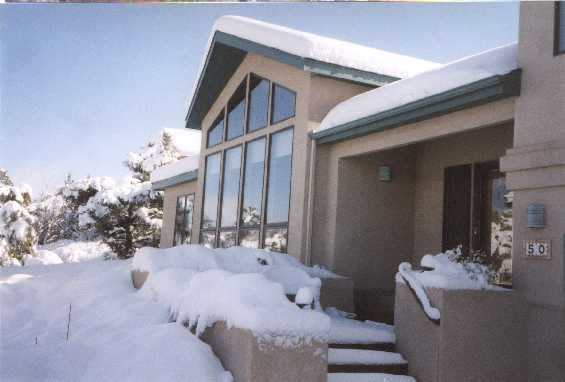
In New Mexico, living at 7,000 feet elevation, we had our mountains and four seasons.The tremendously varied habitats provided great birding. Of course, the nearest shopping centers and health care providers were located twenty or more miles away, accessible only through a single mountain pass that could be choked by a blizzard or a traffic accident. After eleven years we reconsidered our priorities, and took the dramatic step of moving to south Florida, to be near our younger daughter’s family. In lieu of mountains we wanted to look out over water. Eyes that are fixed on a distant vanishing point are eyes at rest.
Our daughter actually selected our Florida home. We ratified her choice and moved here in 2004. We had not yet sold our New Mexico home when, three months later, her husband got a big promotion to Chicago and they moved away with our two baby granddaughters! It took us two years to make the weighty decision to purchase a second home in Illinois. We hoped to balance our newly discovered love of mild Florida winters with our need for family. Now the view was not an issue. We required only a “crash pad,” a place to stay when it was hot and humid back in Florida. We selected a town-home only two miles away from our daughter’s house.

It was a new unit, in one of the first of 36 buildings that were scheduled to be part of a complex with homes for over 200 families. We knew that subsequent construction would fill the surrounding open space and blot our our view of the horizon. The housing crisis hit as the seventh building was finished, and the developer was unable to complete the project. Construction was put off indefinitely, and the land, the equivalent of four or five city blocks around our condo, remained undisturbed for six years. As it returned to an imperfect grassland, it became an unexpected birding treasure. The above photo was taken in 2010, after the land had been healing for four years.
Thunder was usually the only ominous sound under the prairie skies.
Sadly, but not unexpectedly, this week we also heard the roar of bulldozers as the entire area was being cleared and graded. Time to stop and remember how nice it was while it lasted.
Our front door provided an ideal vantage point for viewing birds that rested on the color-coded utility markers. (Click on images for additional views)
American Kestrels nested in one of the large trees along the main road.
Horned Larks built their nests early in the spring near our front doorstep.
Savannah Sparrows sang and defended their territories.
American Pipits visited during migration into winter.
At least one pair of Eastern Meadowlarks raised a family out in the largest open tract.
Red-winged Blackbirds shared a pothole with muskrats.

A pile of construction rubble provided another high perch in the treeless empty lot. We could drive around the corner and park, using the car as a blind, and just wait for the next bird to occupy it. Lazy birding at its best!
Spotted Sandpipers sang all spring. The area had room for several breeding pairs.
Song Sparrows visited and probably nested along the shrubby margins.
For the past two years, Vesper Sparrows serenaded from the roof of our condo and surely found nesting areas in the weeds near the old mound of topsoil left when the area was first cleared.
In spring, melting snow and rain created roadside “fluddles” that attracted other birds. The only photographic challenge was to park with the sun at our back.
Solitary Sandpipers passed through during spring migration.
Sandhill Cranes brought their colts to feed in the field right near our doorstep.
Both Canada and the smaller Cackling Geese made use of the “floodles.”
On one occasion, a “blue” Snow Goose paid a visit (photographed from inside an upstairs window).
A Great Blue Heron seemed to be hunting insects and possibly voles out in the fields.
Red-tailed Hawks roosted on streetlights over empty roadways.
Many Killdeer courted and raised their chicks every spring.
Along the far edge of the property, American Goldfinches, flowers and butterflies delighted us with their color…
..Chicory…
…Summer Azure
I can mourn the loss, but cannot reverse progress, and will revel in remembrances of a plot of land no longer vacant.
Posted by: Ken @ 7:09 am
Just before departing Florida for our second home in Illinois, we managed one final walk in our local wetlands patch. Warblers were still coming through, but not in great numbers. On some days Northern Parulas were common, but we saw only a few.
They all were brightly colored males. Their foraging habits are methodical, as they usually explore one limb at a time, starting at the base of a branch and working out to the very tip. They sometimes emerge into plain view before flying to the next branch, providing photo opportunities.
Prairie Warblers are seen here all year, but their numbers are swollen during migration and winter by temporary visitors. They also tend to spend much time in a small area of a tree, but are not as predictable in their movements.
In quite the opposite fashion, the movements of American Redstarts are totally unpredictable. Many of my attempts to photograph them produce only empty branches. This sweet little female redstart paused just long enough for me to capture her beauty and energy.
This fall, Black-throated Blue Warblers have been favored subjects. The
males have strongly contrasting blue, black and white plumage. They often appeared in small same-species flocks.
I really liked the feather detail in this pose.
Warblers are attracted to fruiting shrubs, usually for the insects they attract, but both the parulas and this Black-throated Blue Warbler have a taste for privet berries.
Female Black-throated Blue Warblers do not resemble the males except for the white mark on each wing.
The face pattern of females is distinctive.
Two Yellow-throated Warblers showed up on our final walk. This was only the second time I had seen this species in our patch.
Common Yellowthroats were, well, common! Usually shy and retiring, their movements are difficult to track as they creep through the low shrubs and tall grasses. The fruiting privet (Ligustrum sp.) lured them into the open, but they seemed interested only in the associated numerous spiders and other insects.
The female yellowthroat lacks the black mask of the male.
Palm Warblers have arrived and will be here all winter. Our local visitors belong to the drab western subspecies. Interestingly, their migratory path crosses that of the more colorful eastern population, which winters in Texas and Mexico.
The Palm Warbler’s long legs are an adaptation to its habit of foraging on the ground. Early morning light enhanced the color of this one.
Another long-legged warbler, the Ovenbird, walked up almost to my feet before I saw it.
We departed Florida before seeing our first Yellow-rumped Warbler, the avian equivalent of the “fat lady” who sings at the end of the opera. Migration is not over until the “butterbuts” appear. We did catch this one the first morning after we arrived in NE Illinois, at local Nelson Lake. Sure enough, it was the only warbler we encountered there.
Of course, we saw many other interesting birds besides warblers during our final week in Florida. A Bell’s Vireo showed up once before, in October of 2009. Although it is a western species, it is a rare but fairly regular visitor to South Florida during spring and fall migrations
A pair of Common Ground-Doves posed in the early morning sun.
Blue Jays collected Live Oak acorns from the bumper crop.
Blue-gray Gnatcatchers can be a pesky distraction when we confuse them with the warblers as they they flit among the branches. However, they also seem to be “magnets” for other migrants, perhaps alerting them to food sources.
Bald Eagles regularly pass overhead just after sunrise, traveling from their nest area two miles to the north, to hunt for fish and water birds in the large lake in our subdivision. They are out earlier on clear mornings, probably because of better visibility.
The songbirds fell silent as a Cooper’s Hawk flew overhead.
A single adult Wood Stork has visited our backyard lake several times during the past month. As if to bid us adieu on the morning of our last day in Florida, a flock of six flew in while it was still dark. I had to wait to take these shots. By then only one remained on our back lawn and the others had flown to the other side of the lake.
Posted by: Ken @ 4:37 am
With a couple of other birders from South Florida Audubon, I visited Corkscrew Swamp east of Naples. This Audubon sanctuary is a marvelous place. If you can read the sign below, it shows the habitat features traversed by more than two miles of boardwalk trails.
Since fall migration is in progress, we rather expected to be treated to many warblers. For some reason this did not happen. There were several warblers, but all were high in the trees, deep in the shadows, or back-lighted by the sky. It was an enjoyable trip, despite the heat and humidity.
Entrance sign (click image to enlarge).
This section of the boardwalk meanders through a Pond Cypress stand.
The Pond Cypress swamp looked promising, but we found relatively few birds.
A Pileated Woodpecker foraged near the entrance. Good views of this species are almost guaranteed on any visit to Corkscrew Swamp.
Great Crested Flycatchers were numerous.
Tufted Titmouse were calling everywhere.
A Carolina Wren was going the other way, but this was the best I could do.
A light morph Short-tailed Hawk flew over, but it was impossible to get a photo through the intervening branches. This Red-shouldered Hawk, seen from the viewing platform in the open Central Marsh area was more cooperative.
Because of the high water that disperses aquatic prey, waders were few and far between. This Little Blue Heron is the only heron we saw within the preserve, though many were out in nearby retention ponds.
A Green Tree Frog clung to a plant stem.
I believe this is a Florida Red-bellied Turtle, but I welcome confirmation of the species.
A Swamp Lily almost seems to glow in the shade of the cypress trees.
A highlight of the walk was seeing two rare orchid species in bloom.
The Clamshell Orchid is quite rare in the Everglades, as it has very demanding habitat requirements. Florida can have cold snaps, and the water in Corkscrew Swamp holds onto the heat and protects tender vegetation. However, this orchid ranges in the tropics from Mexico to Brazil and is common in many orchid collections.
The Ghost Orchid is so called because it lacks leaves, yet from some angles its flower resembles Casper the Ghost. The plant consists only of a spider-like root system that clings to the bark of trees, and flowers that boom infrequently. It grows only under very hot conditions. It is very rare in the wild, and only two specimens are visible from the boardwalk at Corkscrew Swamp.
The second Ghost Orchid had just finished blooming only two days previously. Here is its root system and the dried-up remains of a single flower. The orchid is not a parasite, but an epiphyte that dwells on the tree and derives no nourishment from its host.
Despite the lack of birds, we found many other photographic subjects, including this poisonous White-marked Tussock Moth. Its hairs can cause a nasty painful rash.
I could not identify the species of this orb weaver, but it has rather distinctive dorsal abdominal markings.
Posted by: Ken @ 1:00 pm
It was about 15 minutes after sunrise and cloudy when Mary Lou and I approached the bend in the road at the junction of the unpaved portions of Miramar Parkway and SW 196th Avenue. I had pre-set the ISO at 800 (aperture open all the way to f/5.6) but did not expect to take any photos until after we completed the fast-paced “aerobic” mile into the wetlands adjacent to our subdivision. Only about a quarter mile into our walk, we suddenly saw a Bobcat standing almost in the middle of the road, about 100 yards away.
This was the first time one had posed out in the open roadway like that. We slowly moved up to about 50 yards before the cat fled. Unfortunately, I had kept the camera in an air conditioned room, and the lens fogged up pretty badly in the stifling heat and humidity. I wiped them a few times, but the quality of all the photos suffered.
This was about the sharpest image I got, so I processed it a couple of different ways. The above one is made up of four layers on the cropped original RAW image, each with a different exposure compensation (-1.0, -0.5, +0.5 and +1.0), thus producing an HDR-like effect. The cat suddenly fled towards the levee path that follows south along the 196th Avenue Canal.
I followed the Bobcat’s retreat route up along the levee path, but never caught sight of it again. However, I found very fresh Bobcat scat. The Bobcat dropped these feces out in the open with no attempt to conceal them, suggesting it was a male. Females usually deposit it less conspicuously and often scratch dirt over it as do House Cats. Note heavy black “tar” color due to digested blood, characteristic “Tootsie Roll” segmentation, large bore (~1 inch), inclusion of much hair and few bone fragments.
Three female White-tailed Deer appeared up ahead and walked towards me. I stood motionless , but the sun was getting higher and I became uncomfortably hot and finally started to move into a shady area. This frightened the does. It is a treat to see them here, as they are not very abundant.
I gave up my attempt to stalk the Bobcat and checked out the birds. A Loggerhead Shrike looked down at me from the top of a shrub.
Moving back down the what is left of my “Fake Hammock,” I took a spot in the shade and waited to see which birds might show up. This Northern Mockingbird was one of several moving about.
Predictably, a Prairie Warbler came out of hiding.
An Ovenbird peered out from the deep foliage.
Several Brown Thrashers have congregated in this area, more often heard than seen. This one flew out into the open.
A pair of Common Yellowthroats busily foraged in the low vegetation. The male briefly came out into the light.
Palm Warblers have arrived in good numbers. All are of the somber Western subspecies. Oddly, the east coast birds turn to the southwest before reaching Florida and the Gulf of Mexico, on their way to spend the winter in Texas and Mexico. Their paths cross with the western population, which flies SE to winter in Florida and Cuba. They reverse the criss-cross pattern when returning north in spring.
Suddenly a Northern Waterthrush walked out of the darkness unto a small limb, its tail slowly bobbing characteristically.
The waterthrush paused to look me over before flying off.
A Bald Eagle flew over, tracking a perfect line from its nesting area two miles northwest in Pembroke Pines to the large lake in our subdivision. For updates on our local eagle nest, visit my Bald Eagle Nest Watch FORUM.
On the way home, I saw several White-winged Doves lined up on a neighbor’s roof.













